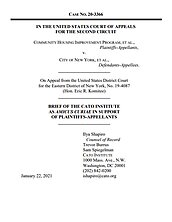When the government doesn’t physically take land but rather passes regulations that greatly undermine traditional property rights, it’s possible that such regulations can be a “regulatory taking” under the Fifth Amendment’s Takings Clause, meaning just compensation is owed to the property owner. With New York’s RSLs, while each provision might not alone rise to a regulatory taking, together they offend the common law “right to exclude.” The right to exclude people from occupying your property is obviously central to the concept of “property.” The Supreme Court has held that even minor interferences with the right to exclude and other fundamental attributes of ownership are per se takings that always require the government compensate affected owners. In those cases, the purpose behind the offending regulation is irrelevant.
Several New York landlord advocacy groups sued New York City and the state in federal court, alleging per se takings of their fundamental right to exclude, among other constitutional claims. The Eastern District of New York rejected their per se takings argument, however, opting instead to subject the RSLs primarily to what is called a “partial regulatory takings” test. Using this flawed test, courts have often been too willing to rubberstamp any and all regulations that only severely, rather than totally, destroy a property’s value or usefulness. New York landlords are fearful of the impact this rubberstamping will have on the increasingly shaky residential rental market. They have appealed the district court’s misguided ruling to the Second Circuit.
The Cato Institute has filed an amicus brief urging the Second Circuit to follow the Supreme Court’s partial lead and extend the per se test to the logical next step. The Court has already applied the per se test to “permanent and continuous” physical invasions (for example, a cable line running through an apartment) but it should extend tointerference with any fundamental attribute of ownership, such as the right to exclude or the right to transfer. When it comes to such rights, it should not matter how extensive the occupation or interference, in terms of duration or the amount of space occupied.
Sometimes regulations that interfere with fundamental attributes of ownership are not takings, but only in limited circumstances. The Supreme Court has long held that the “reciprocity of advantage”—the benefits affected owners gain from the same regulation’s imposition on their neighbors—can serve to compensate burdened owners “in kind.” Yet New York’s RSLs are applied so haphazardly there can be no true reciprocity of advantage. Instead, New York’s RSLs are an obvious wealth transfer, and targeted owners do not realize a net-gain from the arrangement.
Regulating harmful uses is another exception to the per se takings test. Generally, if an owner’s use of their land will harm the public, or serve as a major impediment to the fulfillment of a public need, then a regulation targeting that use does not “take” the owner’s property. Yet it would be very strange to argue that landlords renting apartments at market prices are somehow creating a public harm.
In the absence of these two exclusive excuses for the regulation of a fundamental attribute of ownership, the RSLs imposed on New York’s landlords are nothing short of per se takings. It is high time the work the Supreme Court has begun in this area be drawn nearer to its obvious conclusion.



